Establishment and genetic characterization of six unique tumor cell lines as preclinical models for sinonasal squamous cell carcinoma
- PMID: 24816148
- PMCID: PMC4017217
- DOI: 10.1038/srep04925
Establishment and genetic characterization of six unique tumor cell lines as preclinical models for sinonasal squamous cell carcinoma
Abstract
Sinonasal squamous cell carcinomas (SCC) are rare tumors, etiologically related to occupational exposure to wood and leather dust. In spite of surgical and radiotherapeutic advances, the 5 year survival is still 30-50%. Therefore, alternative treatment options are needed. We report the establishment and characterization of six unique human sinonasal SCC cell lines, named SCCNC1, 2, 4, 5, 6 and 7. In vitro growth and invasion characteristics were evaluated and genetic profiles were compared to those of the original primary tumors. The population doubling times ranged from 21 to 34 hours. Cell lines SCCNC2 and 7 were highly invasive in matrigel. Five cell lines carried a high number of copy number alterations, including amplifications and homozygous deletions, while one showed only three abnormalities. Sequence analysis revealed three cell lines with TP53 mutation and none with KRAS or BRAF. Overexpression of p53 was observed in five, and of EGFR in four cell lines. None of the cell lines showed strong immunopositivity of p16 or presence of human papilloma virus. In conclusion, we have created six new cell lines that are clinically and genetically representative of sinonasal SCC and that will be a useful tool for the preclinical testing of new therapeutic agents.
Figures
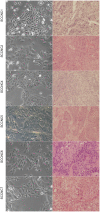
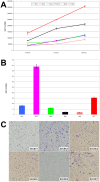
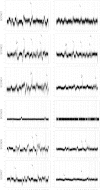
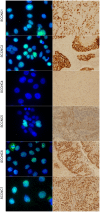
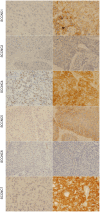
Similar articles
-
Sinonasal carcinoma: clinical, pathological, genetic and therapeutic advances.Nat Rev Clin Oncol. 2014 Aug;11(8):460-72. doi: 10.1038/nrclinonc.2014.97. Epub 2014 Jun 17. Nat Rev Clin Oncol. 2014. PMID: 24935016 Review.
-
Establishment and genetic characterization of an immortal tumor cell line derived from intestinal-type sinonasal adenocarcinoma.Cell Oncol (Dordr). 2011 Feb;34(1):23-31. doi: 10.1007/s13402-010-0002-8. Epub 2011 Jan 18. Cell Oncol (Dordr). 2011. PMID: 21360264
-
Assessment of TP53 and CDKN2A status as predictive markers of malignant transformation of sinonasal inverted papilloma.Sci Rep. 2024 Jun 21;14(1):14286. doi: 10.1038/s41598-024-64901-z. Sci Rep. 2024. PMID: 38902320 Free PMC article.
-
Fibroblast growth factor receptor-1 as a potential therapeutic target in sinonasal cancer.Head Neck. 2014 Sep;36(9):1253-7. doi: 10.1002/hed.23443. Epub 2014 Feb 1. Head Neck. 2014. PMID: 23913758
-
[An overview of the establishment of cell lines from sinonasal malignancies].Zhonghua Er Bi Yan Hou Tou Jing Wai Ke Za Zhi. 2022 Jul 7;57(7):891-894. doi: 10.3760/cma.j.cn115330-20210704-00423. Zhonghua Er Bi Yan Hou Tou Jing Wai Ke Za Zhi. 2022. PMID: 35866287 Review. Chinese.
Cited by
-
Sinonasal carcinoma: clinical, pathological, genetic and therapeutic advances.Nat Rev Clin Oncol. 2014 Aug;11(8):460-72. doi: 10.1038/nrclinonc.2014.97. Epub 2014 Jun 17. Nat Rev Clin Oncol. 2014. PMID: 24935016 Review.
-
High-Frequency Targetable EGFR Mutations in Sinonasal Squamous Cell Carcinomas Arising from Inverted Sinonasal Papilloma.Cancer Res. 2015 Jul 1;75(13):2600-2606. doi: 10.1158/0008-5472.CAN-15-0340. Epub 2015 Apr 30. Cancer Res. 2015. PMID: 25931286 Free PMC article.
-
Investigating the impact of clinical and genetic factors on the post-surgery prognosis of sinonasal squamous cell carcinoma.Sci Rep. 2024 Sep 27;14(1):22167. doi: 10.1038/s41598-024-73157-6. Sci Rep. 2024. PMID: 39333222 Free PMC article.
-
Precision Medicine in Head and Neck Cancers: Genomic and Preclinical Approaches.J Pers Med. 2022 May 24;12(6):854. doi: 10.3390/jpm12060854. J Pers Med. 2022. PMID: 35743639 Free PMC article. Review.
-
An Effective Primary Head and Neck Squamous Cell Carcinoma In Vitro Model.Cells. 2019 Jun 7;8(6):555. doi: 10.3390/cells8060555. Cells. 2019. PMID: 31181618 Free PMC article.
References
-
- Ansa B. et al. Paranasal sinus squamous cell carcinoma incidence and survival based on Surveillance, Epidemiology, and End Results data, 1973 to 2009. Cancer. 119, 2602–2610 (2013). - PubMed
-
- Turner J. H. & Reh D. D. Incidence and survival in patients with sinonasal cancer: a historical analysis of population-based data. Head Neck. 34, 877–885 (2012). - PubMed
-
- Barnes L. Pathology and Genetics of Head and Neck Tumours. World Health Organization Classification of Tumours, vol. 9. (IARC Press, Lyon, 2005).
-
- Bonzini M. et al. Prevalence of occupational hazards in patients with different types of epithelial sinonasal cancers. Rhinology. 51, 31–36 (2013). - PubMed
-
- Sanghvi S. et al. Epidemiology of sinonasal squamous cell carcinoma: A comprehensive analysis of 4,994 patients. Laryngoscope. 124, 76–83 (2014). - PubMed
Publication types
MeSH terms
Substances
LinkOut - more resources
Full Text Sources
Other Literature Sources
Molecular Biology Databases
Research Materials
Miscellaneous

